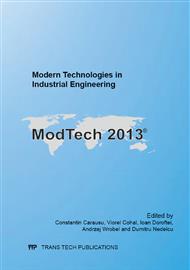p.67
p.71
p.77
p.84
p.88
p.93
p.99
p.105
p.110
The Methods to Study the Influence of the Clearance in the Case of Great Speeds and Small Speeds
Abstract:
In kinematic couplings, clearances are inevitable for their operation. The size of these clearances but as a consequence of use, causes a malfunction of the mechanism to which it belongs. The law of motion of driveline changes, big clearances, non-technological system causes vibration, leading to discomfort, uncertainty, and thus reach its degradation. In the paper we shall make a few of geometric and mechanical type considerations about the clearances in the linkages, linkages planes with joint rotation links. Based on mathematical algorithm developed and applied crank mechanism, the model presented in [1], this paper scientifically developed mathematical model, proposing mathematical models to study the influence of the size of the clearance in general dynamic calculation mechanisms. Mechanism considered is crank connecting rod mechanism with clearance cinematic coupling between rod and crank rotation. The paper makes a study of the influence on the dynamic behavior of the crank rod mechanism at high speeds, but also general method algorithm is developed and accurate method to assess the dynamic behavior of multi-body mechanism. The first case is considered a constant angular speed motor and thus determine the elemental expressions that establish the mechanism position, velocity and acceleration expressions in the two directions heads elements. Finally we obtain the expression of the normal reaction force, as well as position expression that defines its angle. With reaction force can specify phase (contact, flight, impact) [1], the behavior of the journal. For the case of general method - the method multi-body - the exact method are established liaison relationships between the parameters , write matrices , inertia matrix. Use Lagrange equations, if non-holonomic constraints. Matrix differential equation of motion is written and it can be solved numerically using Runge-Kutta method of order four. Of the iterative method, we obtain the parameters used in calculating the reaction force expression that can be evaluated accurately in journal bearings behaviour. Any would be their source of appearance, they usually produce unwished effects during the mechanisms functioning.
Info:
Periodical:
Pages:
88-92
Citation:
Online since:
November 2013
Authors:
Keywords:
Price:
Сopyright:
© 2014 Trans Tech Publications Ltd. All Rights Reserved
Share:
Citation:


